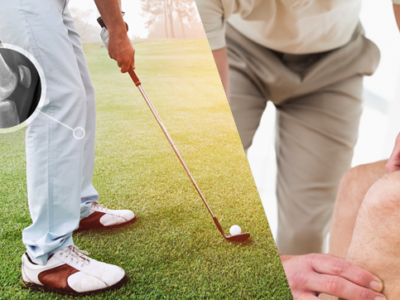By Franciscan Health
Golf is played outdoors and in all types of weather conditions. Cold, wet and windy conditions can lead to discomfort, or injury.
Strains And Sprains
As temperatures decrease, blood flow to the limbs and the elasticity of our muscles, tendons and ligaments also decreases. This prevents our muscles, tendons, and ligaments from working as efficiently as they could. The loss of elasticity increases the risk of sustaining a muscle strain or joint sprain.
A warm up and stretching session prior to your round is always a good idea, but especially when the weather is less than ideal.
Hypothermia
Hypothermia occurs when the core body temperature is below 95°. Hypothermia is classified as mild, moderate, and severe depending on the signs and symptoms present and the core body temperature. It often occurs with extended exposure to cold, wet and/or windy conditions.
Always take extra layers when you head to the golf course. As all golfers know the weather in Indiana can change very quickly.
Frostnip And Frostbite
Frostnip is considered the mildest form of tissue freezing and is a precursor to developing frostbite. Frostnip occurs when only the superficial skin is frozen, and the tissues are not permanently damaged.
Frostbite is the actual freezing of body tissues and onsets with repeated or extended exposure to cold, wet, and/or windy conditions. It occurs when blood is redirected from peripheral tissues to supply vital organs with warm blood. Frostbite, like hypothermia, has stages of severity from mild to severe. It most commonly occurs in the fingers, toes, nose, and ears. Common signs include swelling, redness or mottled gray skin appearance, stiffness, and tingling or burning sensation to the affected area.
Keep an extra pair of gloves in your bag if you are planning to play in cold weather, plus a pair of water-proof golf shoes, not water-resistent, are a must.
Chilblain
Chilblain, also known as pernio, is an inflammatory response to extended exposure to cold, wet conditions. Chilblain most commonly affects the hands and feet, causing small red bumps on the skin, swelling, tenderness, or itching and pain in the affected area. Edema, or swelling caused by excess fluid, can also be present in the skin.
With chilblain, there is prolonged restriction of skin blood vessels (like frostnip and frostbite) which that causes low oxygen levels in the tissue and vessel walls and results in inflammation.
Chilblain develops after extended exposure in the cold, wet conditions, whereas frostnip and frostbite can occur in minutes to hours.
When playing golf in cold and damp conditions, listen to your body and don’t push the envelope.
Preventing Cold Injuries
By reducing your exposure to the weather conditions that can result in cold injuries, you can reduce the likelihood of developing hypothermia, frostbite, sprains and strains, or chilblain while exercising.
If you are spending time exercising outdoors, reduce your chances of sustaining a cold injury by wearing appropriate clothing such as items that are fleece-lined, waterproof, thermal, quick drying and down-filled. Wear multiple layers versus bulky items.










